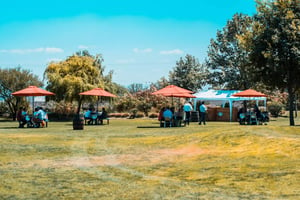How Volunteers Accelerate Nonprofit Impact
Scaling nonprofit impact can be challenging, costly, and seem like an impossible task. Why? Because the problems nonprofits tackle can be a result of systemic oppression where there are no easy solutions. There is, however, a special lever nonprofit leaders can pull to make their missions a little easier… Volunteers.
Volunteers are the unsung heroes of the nonprofit sector. Every year, millions of individuals dedicate their time and talents to causes they believe in, making a significant difference in communities worldwide. The value of their contributions is immeasurable, but if quantified, the financial impact alone is astounding. In 2023, it was estimated that volunteers in the U.S. contributed over $200 billion in services. But the true power of volunteers goes beyond just numbers; they are pivotal in advancing the mission of nonprofits and amplifying outreach efforts.
In this blog, we’ll explore how volunteers accelerate nonprofit impact in two key ways: by directly contributing to mission-driven activities and by serving as advocates who expand the reach of the organization. We’ll also dive into strategies to maximize volunteer potential and the importance of measuring their impact.
The Strategic Role of Volunteers in Advancing the Mission
Volunteers as Mission-Driven Contributors
At the heart of every nonprofit is a mission. Volunteers are often the hands and feet of this mission, directly engaging in activities that fulfill the organization’s goals. Whether it’s tutoring students in an after-school program, serving meals at a homeless shelter, or organizing community cleanups, volunteers are on the front lines, ensuring that the nonprofit’s work reaches those who need it most.
For example, consider a nonprofit focused on environmental conservation. Volunteers might participate in tree-planting events, clean up local waterways, or run educational workshops. Their involvement allows the organization to tackle more projects, cover more ground, and ultimately make a larger impact.
Without volunteers, many of these initiatives would be impossible due to cost constraints alone.
Case Studies: Scaling Mission-Driven Activities
Let’s examine a few examples of nonprofits that have successfully used volunteers to scale their mission-driven activities.
- Feeding America: This nationwide network of food banks relies heavily on volunteers to distribute food to those in need. In 2022, volunteers helped distribute 4.2 billion meals across the country. Without volunteers, Feeding America would have had to significantly reduce its reach, leaving many communities without critical support.
- Habitat for Humanity: Volunteers are the backbone of Habitat for Humanity’s efforts to build affordable housing. By engaging volunteers in construction work, the organization can keep costs low and build more homes for families in need. Since its founding, Habitat for Humanity has partnered with over 895,000 volunteers and served more than 13.4 million people. Imagine what this would cost without volunteers!
- Big Brothers Big Sisters: This mentorship organization pairs volunteers with young people to provide guidance, support, and positive role models. By leveraging volunteers as mentors, Big Brothers Big Sisters can serve more children and expand its reach to new communities.
These case studies demonstrate how volunteers enable nonprofits to scale their operations and make a greater impact. By strategically placing volunteers in key roles, nonprofits can extend their reach and amplify their mission.
Maximizing Volunteer Potential
To fully realize volunteers' potential, nonprofits must align their skills and passions with the organization’s needs. This means going beyond basic tasks and empowering volunteers to take on more responsibility. For example, a volunteer with a background in marketing could help create a social media strategy, while a retired teacher could design educational programs for the nonprofit’s beneficiaries.
Empowering volunteers also involves providing them with the necessary training and resources to succeed. By investing in volunteer development, nonprofits can build a more skilled and committed volunteer base that is capable of making a significant impact.
Pro tip: Use your volunteer management platform to streamline these efforts.
Volunteers as Mission Advocates
Volunteers as Ambassadors
In addition to reducing operational costs by directly contributing to mission-driven activities, volunteers also serve as powerful advocates for the organization. When someone volunteers for a cause they care about, they naturally become an ambassador, spreading the word and encouraging others to get involved. This word-of-mouth marketing is invaluable for nonprofits as it helps build awareness and attract new supporters.
For example, a volunteer who helps out at a local animal shelter may share their positive experience with friends, family, and coworkers, inspiring them to donate, adopt a pet, or volunteer themselves. In this way, volunteers extend the nonprofit’s reach far beyond its immediate network.
Building a Volunteer-Driven Community
Creating a sense of community among volunteers is essential for fostering engagement and encouraging them to become advocates. When volunteers feel connected to the organization and each other, they are more likely to share their experiences and bring others on board.
Nonprofits can build a volunteer-driven community by organizing social events, providing recognition and rewards, and creating opportunities for volunteers to connect and collaborate. For example, a nonprofit might host a volunteer appreciation event where volunteers can network, share stories, and celebrate their collective impact.
When volunteers feel valued and connected, they are more likely to become lifelong advocates for the organization, spreading the word and helping to recruit new volunteers and donors.

Engaging Volunteers in Advocacy
Volunteers can also play a crucial role in advocacy efforts, from lobbying for policy changes to organizing awareness events. For example, a nonprofit focused on environmental protection might engage volunteers in grassroots advocacy campaigns, such as writing letters to legislators or organizing community rallies.
One powerful example of volunteer-driven advocacy comes from the American Cancer Society’s “Relay for Life” events. Volunteers across the country organize and participate in these fundraising events, raising millions of dollars for cancer research and support services. In addition to raising funds, Relay for Life events raise awareness about cancer prevention and treatment, making a significant impact on public health.
By involving volunteers in advocacy efforts, nonprofits can amplify their voice and influence, driving meaningful change on a larger scale.
Measuring the Impact of Volunteers
The Importance of Impact Measurement
While the contributions of volunteers are invaluable, it’s essential for nonprofits to measure their impact to demonstrate value and improve their programs. Impact measurement goes beyond tracking volunteer hours; it involves assessing the outcomes and benefits of volunteer involvement.
For example, a nonprofit that runs a tutoring program might measure the academic improvement of students who receive tutoring from volunteers. A food bank might track the number of meals distributed by volunteers and the impact on food insecurity in the community.
By measuring impact, nonprofits can showcase the value of their volunteer programs to donors, stakeholders, and the broader community. It also allows organizations to identify areas for improvement and make data-driven decisions to enhance their volunteer programs.
Tools and Metrics for Volunteer Impact
To effectively measure volunteer impact, nonprofits can use a variety of tools and metrics. Some common metrics include:
- Volunteer hours: The total number of hours contributed by volunteers.
- Number of beneficiaries served: The number of individuals or communities directly impacted by volunteer efforts.
- Financial value of volunteer contributions: The estimated monetary value of volunteer hours, based on the fair market rate for the services provided.
- Outcomes and achievements: The specific results achieved through volunteer efforts, such as improved health outcomes, increased access to education, or environmental restoration.
Several volunteer platforms, such as Golden Volunteers, offer tools for tracking and analyzing volunteer data. These volunteer management platforms can help nonprofits streamline their impact measurement processes and generate detailed reports on volunteer contributions.
The Long-Term Benefits of Impact Measurement
Measuring and communicating volunteer impact has long-term benefits for nonprofits. It can help attract more volunteers by demonstrating the value of their contributions, improve volunteer retention by showing appreciation for their work, and secure additional funding by providing evidence of the nonprofit’s effectiveness. Consider ways you can showcase your organization’s volunteer efforts in your nonprofit’s impact report.
For example, a nonprofit that tracks the impact of its volunteers might use that data to create compelling stories for fundraising campaigns, grant applications, or annual reports. By showcasing the tangible outcomes of volunteer efforts, the organization can build trust and credibility with donors and stakeholders.
Conclusion
Volunteers are more than just helpers; they are a strategic asset that can accelerate a nonprofit’s impact in profound ways. From directly contributing to mission-driven activities to serving as passionate advocates, volunteers extend the reach and effectiveness of nonprofits, helping them make a greater difference in the world.
As nonprofits continue to navigate resource constraints and growing demands, leveraging the power of volunteers is more critical than ever. By aligning volunteer roles with organizational needs, building a strong volunteer-driven community, and measuring impact, nonprofits can unlock the full potential of their volunteer programs and achieve lasting success.
So, whether you’re a small grassroots organization or a large national nonprofit, take the time to evaluate how you’re currently engaging volunteers and explore new ways to maximize their impact. The results could be transformative for both your organization and the communities you serve. If you feel you need more assistance, don’t hesitate to reach out to our team of nonprofit consultants at Social Impact Solutions.
About the Author
 John Mark Vanderpool
John Mark Vanderpool
Co-Founder, Social Impact Solutions
About Social Impact Solutions
At Social Impact Solutions, we know you want to be a pioneer in transforming your cause. In order to do that, you need an inspired donor base that understands your value. The problem is your donors and stakeholders are confused which makes you feel frustrated, overwhelmed, and that your nonprofit is undervalued.
At Social Impact Solutions, we get it.
We believe that it’s wrong that nonprofits like you lack the resources they need to achieve their impactful goals.
That is why our team is dedicated to helping nonprofits raise more money, so they can increase their impact. We are here to provide you with clear communication strategies and insightful impact metrics to help advance your cause. You can choose the path that is right for you! From our newsletter, The Nonprofit Post, a growth strategy session, or ongoing services, Social Impact Solutions is committed to helping you advance your cause.





